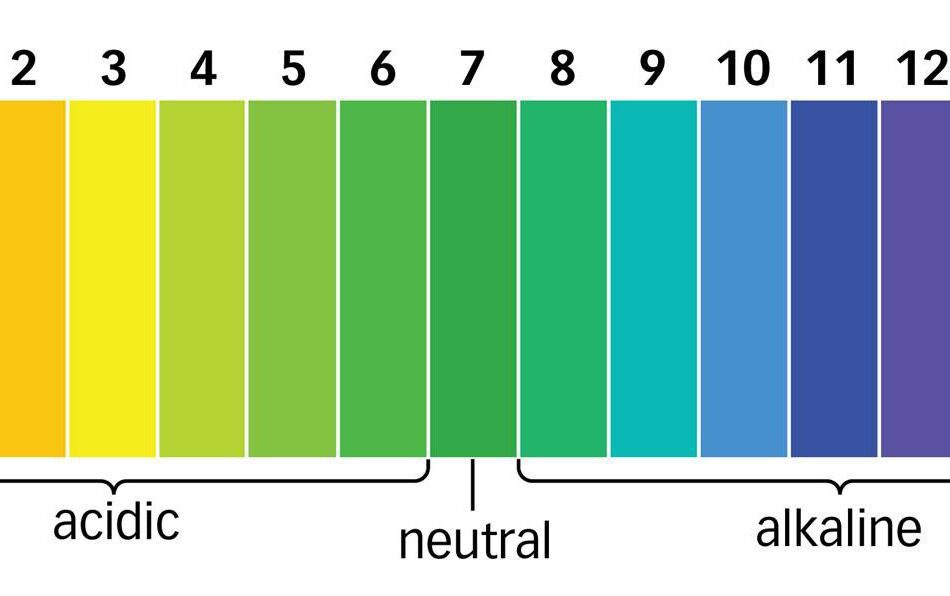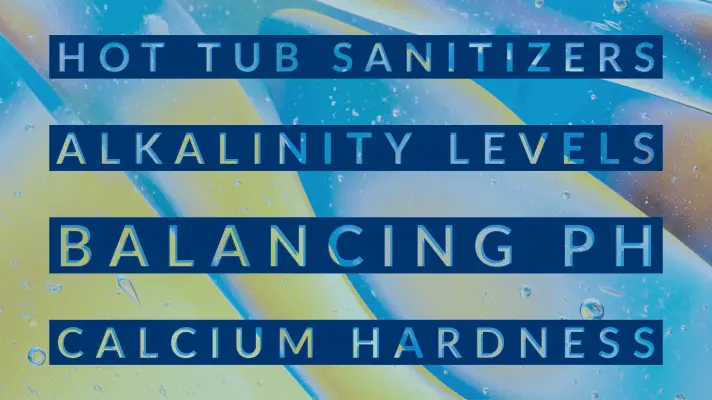
The ideal pH level in both swimming pools and hot tubs is 7.4 to 7.6. This is the level where water is most comfortable for swimmers while also maximizing chlorine’s sanitizing ability.
Buckle up for an introduction to hot tub chemistry. At the heart of hot tub maintenance lies the rules of basic chemistry. Monitoring and maintaining chemicals in your hot tub is the best form of problem prevention. There are many reasons why you should treat your spa water. To help prolong the life of your spa, we’ve put together a beginner’s guide on hot tub chemistry.
Here’s what’s on the class agenda today:

It’s important to monitor your hot tub’s health as you would your own well-being. The stability of your hot tub water will directly impact your own health. Stay informed and be safe about the practices you engage in during any hot tub maintenance.
Misconception #1: I can vacuum and drain my hot tub water regularly as a sole maintenance routine.
Although these can be effective methods in cleaning your hot tub, they’re not realistic and you’ll end up performing more labor than necessary.
Misconception #2: Bleach is an effective sanitizer and can be used in replacement of Chlorine or Bromine.
While bleach is cheaper than other hot tub sanitizers on the market, it won’t work effectively with other chemicals. In addition, the harsh chemical will indefinitely cause damages to your skin and the surface of your hot tub.
Chlorine and Bromine are both effective hot tub sanitizers. A stable sanitizer will keep your tub free of algae, bacteria, and other germs. As mentioned above, it’s never a good idea to substitute bleach for chlorine or bromine. Investing in a quality sanitizer is best for the health of you and your hot tub in the long run. Depending on the environment your hot tub lives in, indoor or outdoor, you may want to consider the benefits and drawbacks of both sanitizers respectively.
The most well-known sanitizer is chlorine. It’s cost-effective and does wonders killing off bacteria. The ideal parts-per-million ranges from 1.0 ppm to 3.00 ppm. We recommend you maintain at the higher end of the range. They have a higher concentration of contaminates than swimming pools. Chlorine kills contaminates by oxidizing bacteria down to it’s chemical structure. Through the process of oxidation, contaminants are transformed into chloramines. The “chlorine smell” isn’t caused by the sanitizer itself, but by the chloramines as a result of the sanitizer. If the chlorine smell is present or overbearing, it’s indicating a lack of free chlorine. In this case, you’ll need to re-sanitize or shock your tub to increase the chlorine’s fighting power.
Want to learn more about the effects of chlorine and how it works? Check out our article, What Should Chlorine Levels be in Swimming Pools and Hot Tubs?

The ideal pH level in both swimming pools and hot tubs is 7.4 to 7.6. This is the level where water is most comfortable for swimmers while also maximizing chlorine’s sanitizing ability.
Alternatively, you can use bromine as a hot tub sanitizer. It’s a chlorine based chemical, so it is not a solution for those who are allergic. Bromine is popular with indoor jacuzzis and in warmer climates. The ideal parts-per-million ranges from 3.00 ppm to 5.0 ppm. Instead of oxidizing contaminants as chlorine does, bromine undergoes a process called ionizing. While they are similar in resulting waste product in the end, bromine has a longer activation window compared to the breakdown of combined chlorine. The waste by-product of bromine are called bromamines. Although the window of sanitizing power is longer, is unstable and can burn off quickly if outdoors and uncovered.
Alkaline materials are chemical compounds that act as a buffer. They are the opposite of acidic materials. Maintaining alkalinity levels will stabilize And can potentially raise your pH as well. The ideal total alkalinity level is 80 to 120 ppm. However, for hot tubs we recommend having it lower.
The rationale for having lower total alkalinity in spas than the recommended range of 80-120 for pools is that the less alkaline the water is, the more effective free chlorine will be. Spas have a much higher concentration of contaminants than pools, which is why we recommend the trade-off between more having stable pH and sanitizing power of free chlorine. You won’t go wrong maintaining your total alkalinity at a range of 80-120 in your spa, as you would your pool. However, you will likely find yourself using more chlorine to keep your spa sanitary.
The most well known chemical used to stabilize the pH of your spa is Cyanuric Acid. It’s also known as Chlorine stabilizer.
“Alkaline materials are an important presence in your pool water because many of the contaminants in pool water are acidic. For example, urine typically has a pH of about 6. Chlorine solutions can also be acidic.”
Pool Calculator Maintenance Blog – The Relationship Between pH & Total Alkalinity
Total alkalinity is to pH what cyanuric acid is to free chlorine. Total alkalinity stabilizes pH levels.
As mentioned above, the pH level of your spa directly correlates to the chlorine’s ability to sanitize it. The ideal pH level for hot tubs is 7.2 to 7.8. If the pH level is too low, it’s acidic and can leave damages to the surface of your tub. When the pH is too high, it destabilizes the sanitizing ability of free chlorine, leaving bacteria to grow freely.
We recommend using baking soda to raise the pH levels in your spa. To lower the pH, use muriatic acid or sodium bisulfate. It’s a good idea to invest in a product particularly made for lowering your hot tub’s pH level. Follow the instructions on the product to make sure you’re adding the correct amount for the size of your spa.
There is SO much to know about pool chemistry. You could really fall down the rabbit hole on some of this stuff. We’re here to help. If you’d like to know more about the relationship between pH and total alkalinity, click here.
If you’ve got a spa, you may want to keep Calcium Hardness at least 100 to 150 ppm to reduce foaming.Total hardness is the sum of calcium hardness and magnesium hardness. Most test strips report TH instead of CH. The ratio of calcium to magnesium varies. As an approximation you can multiply TH by two thirds to get a rough estimate of CH.
To learn more about the Calcite Saturation Index, see our article on What is Calcium Hardness?

Want to learn more about algaecide? Read on to find out when to add algaecide to your pool maintenance routine and other helpful tips.

In this quick guide, we’ll answer the question “can you over shock a pool” and unveil the factors to consider when shocking a pool.

Maintaining both pH and total alkalinity in your swimming pool is important for keeping your pool properly sanitized and non-corrosive. Total alkalinity is to pH what cyanuric acid is to free chlorine. Total alkalinity stabilizes pH levels. The ideal pool pH level is 7.4 to 7.6. The ideal total alkalinity level is 80 to 120 ppm.

The Association of Pool and Spa Professionals recommends free chlorine levels for both swimming pools and hot tubs be kept between 2.0 and 4.0 ppm. However, the Center for Disease Control recommends free chlorine stay above 1 ppm in pools and 3 ppm in hot tubs.